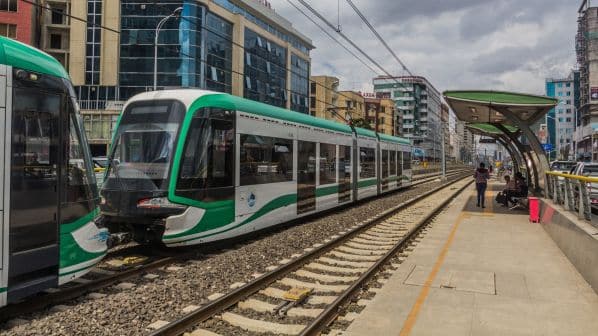CHINA has agreed to provide spare parts worth Yuan 155m ($US 23m) for the Chinese-built Addis Ababa light rail network, with 23 of the network’s 40 LRVs currently inoperable.
The deal was signed on February 14 by Ethiopia’s finance minister, Mr Ahmed Shide, and the Chinese ambassador, Mr Zhao Zhiyuan, in accordance with the economic and technical cooperation agreement signed by China and Ethiopia two years ago. The agreement covers 573 specific spare parts.
The head of the Addis Ababa transport bureau, Mr Mitku Asmare, told Ethiopian newspaper The Reporter that the light rail network, which has been operating since November 2015, would need about $US 60m worth of repairs.
Low ticket prices, overcrowded and limited services, and electricity supply problems have reportedly made it difficult for the light rail network to generate sufficient income to cover its operating costs.
Ethiopian Railway Corporation (ERC) awarded a consortium of China Railway Engineering Corporation (CREC) and Shenzhen Metro Group a five-year contract worth $US 116m to maintain the network in 2014.
The light rail network generated $US 11.1m in revenue in its first four years but cost $US 154m to operate, putting it behind in making scheduled repayments for the loans that funded construction. Since ticket revenue cannot meet operating and fleet maintenance costs, the Addis Ababa city administration has been covering the shortfall.
The Ethiopian capital’s 32km two-line network connects the city centre with suburban areas. It was built by China Railway Eryuan Engineering Group (CREEC), a subsidiary of China Railway Group, and funded by a $US 475m loan from China Exim Bank. When the first line opened in September 2015, it was the first modern light rail line in Sub-Saharan Africa.
The South China Morning Post reports that the fare was set at around Birr 2 ($US 0.03) to ensure it was affordable. However, it says services are infrequent due to the lack of rolling stock and drivers.
Ethiopia has been struggling to service its loans, forcing it to seek debt relief from its foreign lenders including China, which is one of its major creditors. According to the database of Chinese loans to Africa maintained by Boston University’s Global Development Policy Center, China pledged $US 13.7bn in loans to Ethiopia between 2000 and 2020 to build roads, hydro-electric dams and rail projects.

